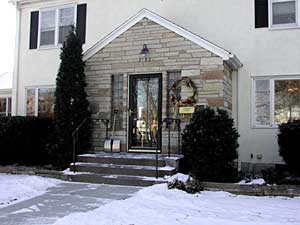|
Audio
Photos
Resources
Respond to this story
|
Living with AIDS is easier at Clare House
January 6, 2004
 |
| Clare House in St. Paul houses four people with HIV or AIDS. The facility celebrates its 10th anniversary this year. (MPR Photo/Greta Cunningham) |
St. Paul, Minn. — Initially the mission of Clare House was to provide 24-hour care for people dying of AIDS. Today, thanks to advances in the treatment of AIDS and HIV, workers and volunteers are focused on helping people rehabilitate their health and live longer.
MPR's Greta Cunningham met with Lee Lewis, executive director of Clare House, to tour the four-bedroom home and to discuss the way his work has changed over the past few years.
Lewis says combination therapies became available to patients just as the house was opening 10 years ago.
 | |||
The drug therapies do not cure the disease, but can delay people with HIV from progressing to AIDS. The drugs can also improve survival rate and quality of life among those with AIDS.
The Minnesota Department of Health reports the number of AIDS cases diagnosed in the state grew steadily in the late 1980s and 1990s. State officials say the number peaked in 1992, when 370 new cases of AIDS were diagnosed. Beginning in 1996, both the number of newly-diagnosed AIDS cases and the number of deaths among AIDS patients declined sharply.
According to the Minnesota AIDS Project, there are about 4,500 Minnesotans living with HIV in Minnesota today.
Care at Clare House is paid for mostly by the county, state and federal government. It costs about $145 a day to care for each resident. Most of the people who live at Clare House do not have private insurance, and are accepted into the program due to their low incomes.
 | |||
Lee Lewis says once people are diagnosed with HIV or AIDS, they often have to take a lot of time off of work to recieve treatments -- and that can often lead to financial problems and difficulty finding affordable housing. Lewis says one of the main missions at Clare House is to provide a stable living situation for people in a health crisis.
Clare House is expanding its services. Officials will soon break ground in northeast Minneapolis for Clare Apartments. It'll be a 30-unit complex along Central Ave. that will provide supportive care for people living with HIV and AIDS. The project will cost $6.7 million.
Unlike Clare House, the apartments are designed for people who do not need 24-hour care. Most of the apartments will be rented to low-income residents, and 10 units will be set aside specifically for homeless people with HIV and AIDS. Residents should start moving into the apartments next fall.
To listen to Greta Cunningham's interview with Lee Lewis, click the audio link in the right column.
|
News Headlines
|
Related Subjects
|
